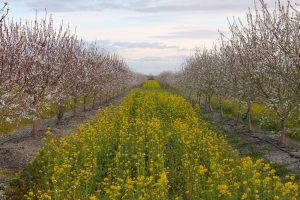Share this article
California program offers lesson in the buds and the bees
In California, bees are critical to the success of almonds and other crops, but the massive acres of farmland those crops grow on can be important to bee health, too.
That’s where Project Apis m. comes in. The nonprofit bee research organization runs a program, which encourages orchard owners to make use of the land between tree rows by planting cover crops that flower at critical times for the bees, before and after the trees blossom. The cover crops provide important nutrients for both honey bees and wild bees, which in turn help pollinate the orchards.
“The almond industry is so vital to the beekeeping industry and vice versa,” said Billy Synk, director of pollination programs for Project Apis m., which takes its name from the honey bee’s scientific name, Apis mellifera. “Almonds are a place where we know that the bees are going to be, and we know they’re going to be hungry and that the almond growers value the bees.”
 California’s Central Valley has some 1.24 million acres of orchards of almonds, a $5 billion crop in the state. To pollinate those 130 million trees, growers bring in about two colonies of bees per acre. That’s over 2 million colonies of bees trucked in from across the country each year — the vast majority of the nation’s 2.5 million bee colonies.
California’s Central Valley has some 1.24 million acres of orchards of almonds, a $5 billion crop in the state. To pollinate those 130 million trees, growers bring in about two colonies of bees per acre. That’s over 2 million colonies of bees trucked in from across the country each year — the vast majority of the nation’s 2.5 million bee colonies.
“The bees are driving the almonds; he almonds are driving the bees,” Synk said. “They’re definitely codependent industries.”
The two industries worked together to create Project Apis m.’s Seeds for Bees program. Sponsored in part by the Bayer Bee Care Program, it offers free seeds to growers to plant cover crops in and around their almond orchards. The cover crops bloom at an important time for the bees. Almonds begin to bloom in March, but in the winter months before that, the bees are at their weakest point all year.
“They haven’t seen a sunny sky or a pretty flower in months,” Synk said.
Wildflowers in the Seeds for Bees mustard mix bloom in January. When bees bring that pollen into the hive, Synk said, it sets in motion the workings of a healthy hive. The queen lays eggs. Her pheromones trigger the hive to start foraging. The bees become healthier, more active and more productive.
The program offers two other mixes — clover and vetch — which bloom after the almond blossoms fall and before the bees are trucked off to pollinate apples, blueberries and cranberries.
By extending the duration, diversity and density of blooms, the forage helps the bees survive the winter and makes them stronger pollinators. For the growers, the cover crops also provide additional advantages, Synk said, including improving the soil, increasing water availability and preventing erosion.
Those multiple advantages have helped convince more and more growers to take part. Since its inception nearly 12 years ago, the Seeds for Bees program has doubled its acreage, reaching 6,000 acres planted last year.
“Sure, these cover crops are providing habitat,” Synk said, “but think of it as a tool of sustainability in the grower’s tool box, too.”
Header Image: A bee gathers pollen from a clover planted as a cover crop in a California almond orchard. ©Billy Synk








